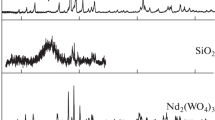Abstract
Composites {Me2(WO4)3 − xWO3} (Me = Sc, In) (x = 0.5–99%) are synthesized and characterized by XRD and electron microscopy methods and also by the density and specific surface measurements. Temperature dependences of the total conductivity of composites are measured. The contributions of σtot and σel are assessed by the \(\sigma (a_{O_2 } )\) and EMF methods. The concentration dependences of conductivity and activation energy are plotted based on the σtot and σion data. It is shown that (a) in the interval x = 0–30 vol % WO3 (0–70 mol %), the conductivity is independent of composition and the ionic component prevails; (b) in the interval x = 60–94.5 vol % (90–99 mol %), the electron conductivity prevails and increases with the increase in x; (c) in the x interval of 30–60 vol % WO3 (70–90 mol %), the conductivity is mixed, i.e., electron(n-type)-ionic; the latter region represents the transition interval from ionic to electron conductivity as x increases. These data are compared with the results obtained earlier for MeWO4-WO3 composites (Me = Ca, Sr, Ba). As regards the structural topology, the {Me2(WO4)3 − xWO3} composites pertain to the randomly distributed type. It is shown that in contrast to {MeIIWO4 · xWO3} composites, the composites under study do not form the nonautonomous interface phase with the high ionic conductivity. The possible reasons for the observed differences in the topology and the conduction type of composites based on MeWO4 and Me2(WO4)3 are analyzed.
Similar content being viewed by others
References
Uvarov, N.F., Kompozitsionnye tverdye elektrolity (Composite Solid Electrolytes), Novosibirsk: SO RAN, 2008.
Maier, J., Solid State Ionics, 2003, vol. 157, p. 291.
Maier, J., Solid State Ionics, 2004, vol. 175, p. 7.
Neiman, A.Ya., Pestereva, N.N., Sharafutdinov, A.R., and Kostikov, Yu.P., Russ. J. Electrochem., 2005, vol. 41, p. 598.
Yongkai, Zhou, Adams, S., Prasada, Rao R., Edwards, D., Neiman, A., and Pestereva, N., Chemistry of Materials, 2008, vol. 20, p. 6335.
Kulikova, T., Neiman, A., Kartavtseva, A., Edwards, D., and Adams, S., Solid State Ionics, 2008, vol. 178, p. 1714.
Zhou, Y., Neiman, A., and Adams, S., Phys. Status Solidi (b), 2011, vol. 248, p. 130.
Neiman, A.Ya. and Kulikova, T.E., Russ. J. Electrochem., 2007, vol. 43, p. 682.
Neiman, A.Ya., Solid State Ionics, 1996, vol. 83, p. 263.
Imanaka, N. and Tamura, S., Bull. Chem. Soc. Jpn., 2011, vol. 84, p. 353.
Diagrammy sostoyaniya sistem tugoplavkikh oksidov: Sprav. Vyp. 5. Dvoinye sistemy (Phase Diagrams of Refractory Oxides. Handbook. No. 5. Binary Systems), Leningrad: Nauka, 1989, part 4.
Richard, A. and Edwards, D., J. Solid State Chem., 2004, vol. 177, p. 2740.
Hiraiwa, M., Tamura, S., Imanaka, N., Adachi, G., Dabkowska, H., and Dabkowski, A., Solid State Ionics, 2000, vol. 136–137, p. 427.
Imanaka, N., Kobayashi, Y., Tamura, S., and Adachi, G., Solid State Ionics, 2000, vol. 136, p. 319.
Kobayashi, Y., Tamura, S., Imanaka, N., and Adachi, G., Solid State Ionics, 1998, vol. 113–115, p. 545.
Samsonov, G.V., Fiziko-khimicheskie svoistva okislov (Physicichemical Properties of Oxides), Moscow: Metallurgiya, 1978.
Chebotin, V.N. and Perfil’ev, M.V., Elektrokhimiya tverdykh elektrolitov (Electrochemistry of Solid Electrolytes), Moscow: Khimiya, 1978.
Neiman, A.Ya., Uvarov, N.F., and Pestereva, N.N., Solid State Ionics, 2007, vol. 177, p. 3361.
Ukshe, E.A., Ukshe, A.E., and Bukun, N.G., in Issledovaniya v oblasti khimii ionnykh rasplavov i tverdykh elektrolitov: Sb. nauch. tr. (Studies in the Field of Ionic Melts and Solid Electrolytes. Collection of Papers), Kiev: Naukova dumka, 1985, pp. 3–17.
Sawada, S., Ando, R., and Nomura, S., Phys. Rev., 1951, vol. 84, p. 1054.
Author information
Authors and Affiliations
Corresponding author
Additional information
Original Russian Text © A.Ya. Neiman, A.V. Karapetyan, N.N. Pestereva, 2014, published in Elektrokhimiya, 2014, Vol. 50, No. 1, pp. 66–77.
Rights and permissions
About this article
Cite this article
Neiman, A.Y., Karapetyan, A.V. & Pestereva, N.N. Conductivity of composite materials based on Me2(WO4)3 and WO3 (Me = Sc, In). Russ J Electrochem 50, 58–69 (2014). https://doi.org/10.1134/S1023193512110122
Received:
Published:
Issue Date:
DOI: https://doi.org/10.1134/S1023193512110122




